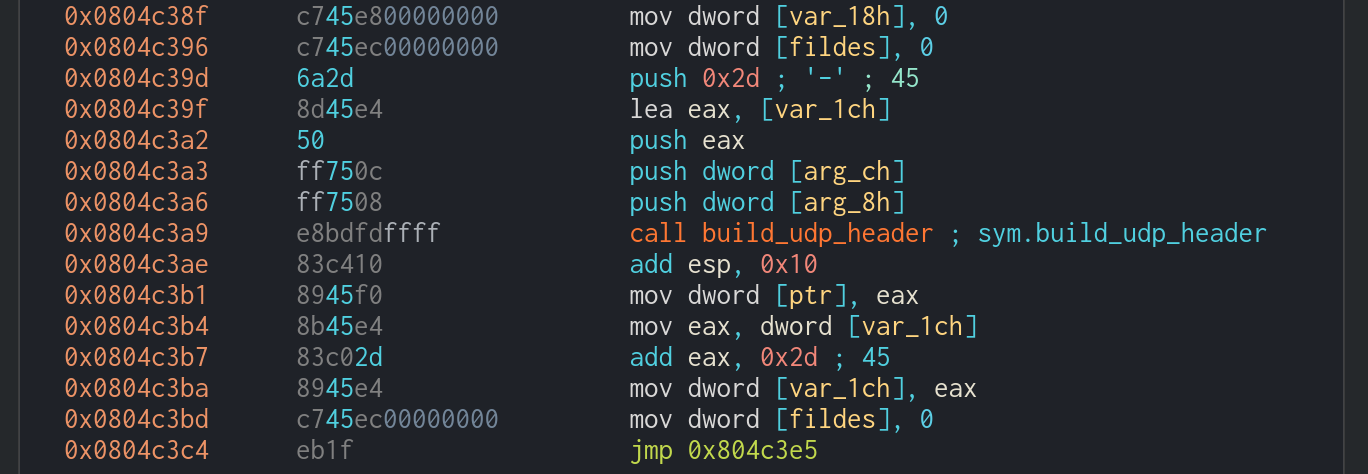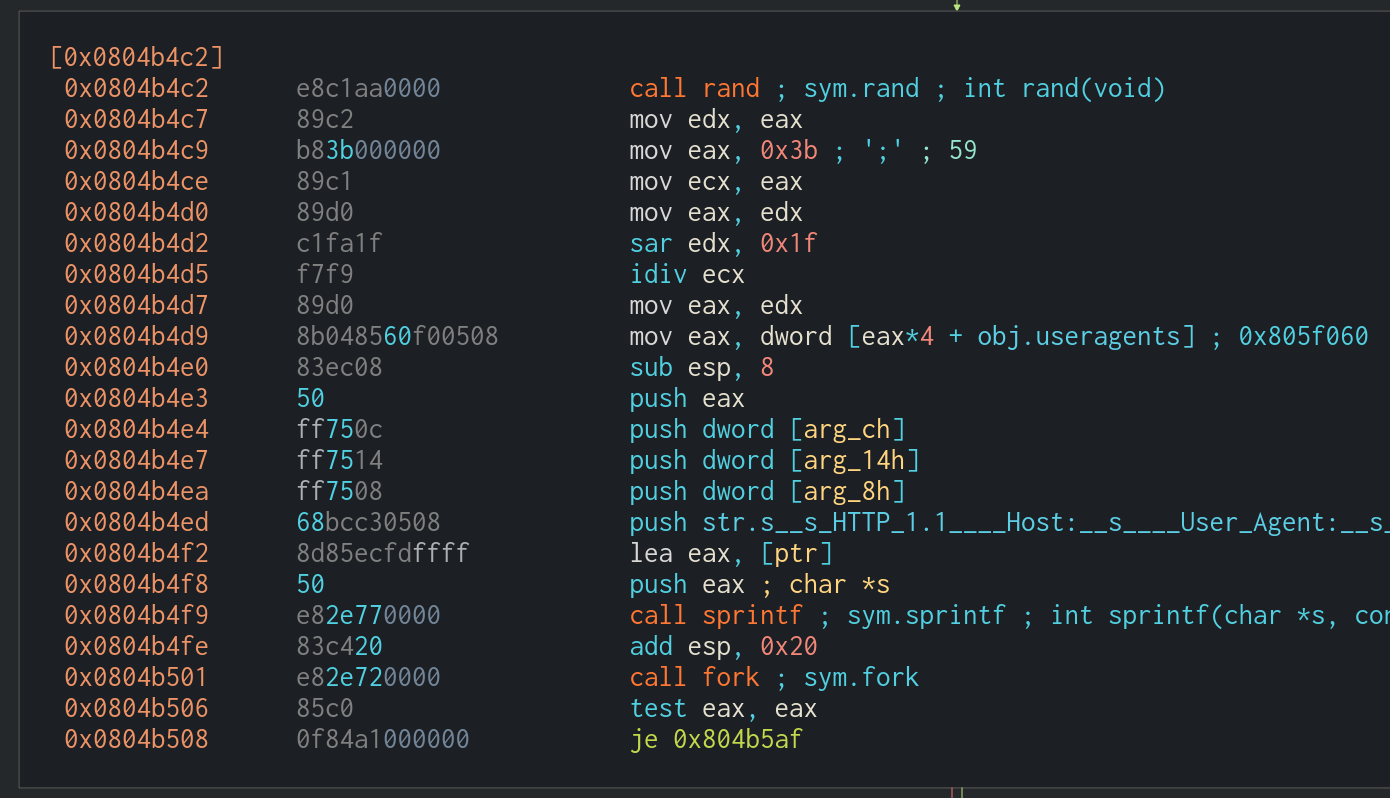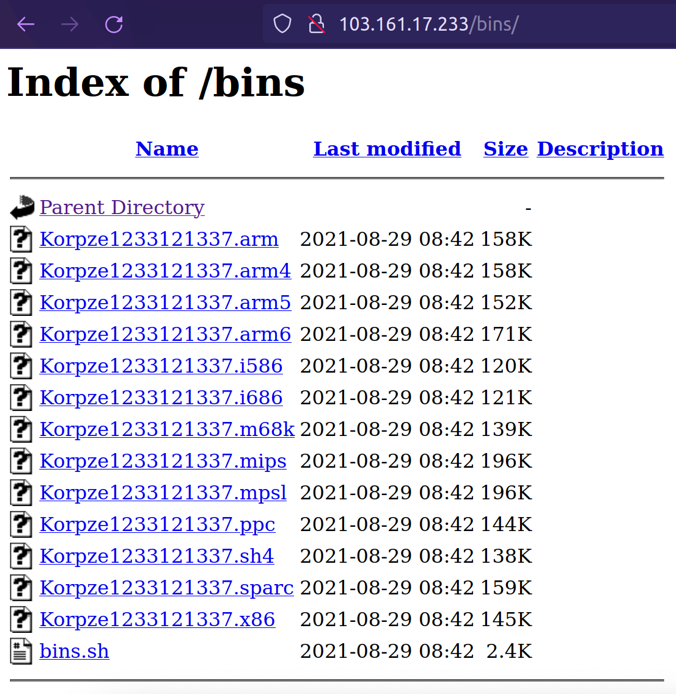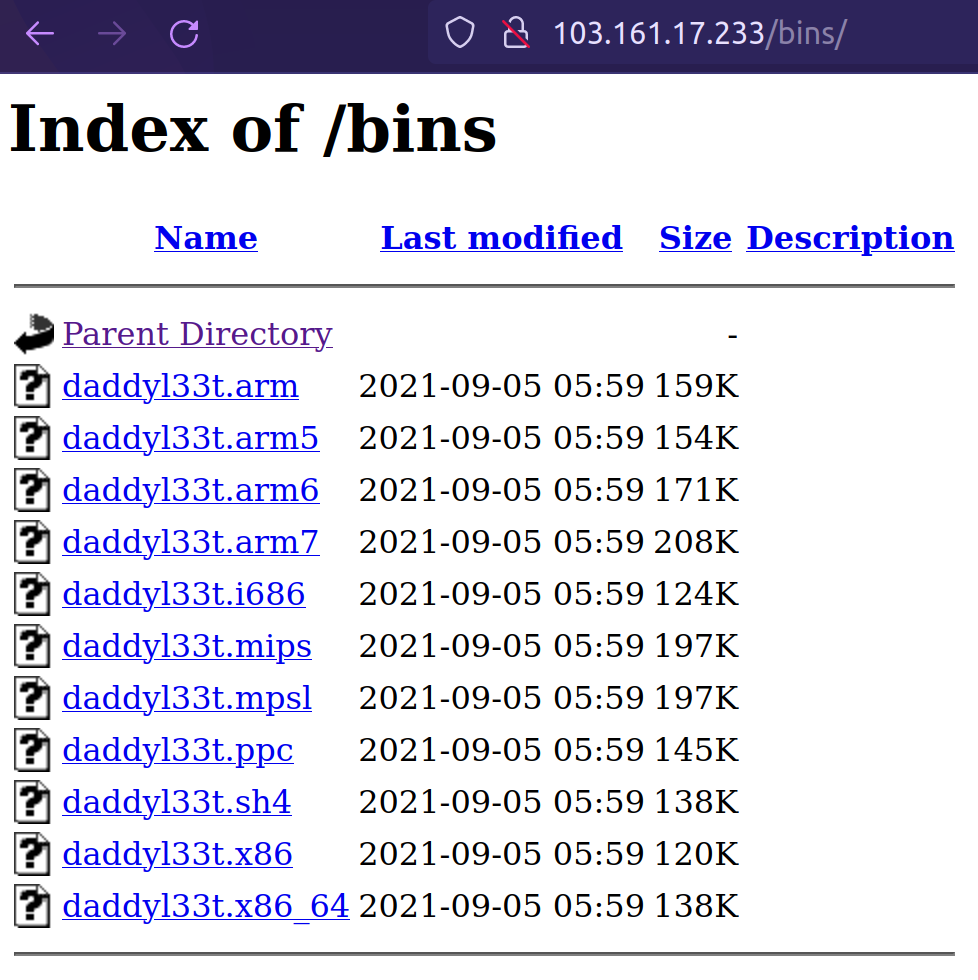Threat Alert: Mirai/Gafgyt Fork with New DDoS Modules Discovered

On the 27th of August, we have found evidence that an IoT device in one of our customer environments had accessed a malicious software sample. We have investigated the sample and discovered that a Gafgyt fork has been updated and it is now being distributed with two new Distributed Denial of Service (DDoS) modules to launch attacks against targeted machines.
Mirai and Gafgyt have been the go-to IoT malware for many years now in cybercrime circles: their versions have successfully infected millions of vulnerable IoT devices over the years. Since their source code have been released publicly, many threat actors use the Mirai or Gafgyt code as a malware-skeleton and then retrofit it with their unique improvements, creating their own special version of the botnet.
In this short threat alert, we will detail the most important findings related to this new malicious campaign.
Overview of the New Mirai/Gafgyt Fork
Two interesting entries in our logs started the investigation. Previously, we have not observed the name “Korpze” as a campaign tag. The set of numbers at the end of the filename suggests a random keyboard typing with a reference to the l33t internet-slang with “1337”.
Date: 27-08-2021 16:31 UTC URL: http://103[.]161[.]17[.]233/bins/Korpze1233121337[.]sparc Date: 27-08-2021 15:47 UTC URL: http://103[.]161[.]17[.]233/bins/Korpze1233121337[.]mpsl
Technical Details
All of the investigated malware samples had retained their debug information and symbols, their binaries had not been stripped, which is, as we have observed, standard with these campaigns, as malware operators do not pay much attention to operational security.

Origins of the New Botnet
There are two references in the binary to YakuzaBotnet and Scarface, the developer of a Mirai variant:
YakuzaBotnet
Scarface1337Self Rep Fucking NeTiS and Thisity 0n Ur FuCkInG FoReHeAd We BiG L33T HaxErS
It suggests that the base of this variant was most likely taken from Yakuza botnet, a Mirai variant leaked to the public:
How the Botnet Gains an Initial Foothold
The function telnet_scanner_init is in charge of setting the initial foothold in vulnerable devices. It scans randomly generated IPs and tries to log in with a list of pre-defined, hardcoded credentials on port 23 (Telnet).
These leaked credentials are the default credentials of many poorly secured IoT devices. Users are strongly advised to change these passwords once they purchase the following appliances:
| Username | Password | Related appliance |
| admin | admin | – |
| admin | smcadmin | SMC routers |
| default | default | – |
| ftp | ftp | – |
| guest | 12345 | – |
| guest | guest | – |
| mg3500 | merlin | Camtron IP cameras |
| root | calvin | Dell DRAC/iLO |
| root | cat1029 | HiSilicon IP cameras/DVRs/NVRs |
| root | gm8182 | Grain Media DVR |
| root | hi3518 | HiSilicon IP cameras/DVRs/NVRs |
| root | icatch99 | Lilin DVR |
| root | pon521 | GPON module DFP-34G-2C2 |
| root | root | – |
| root | root621 | SNR-ONU-EPON-1G |
| root | xc3511 | VTA-83170 DVR |
| root | xmhdipc | HiSilicon IP cameras/DVRs/NVRs |
| root | vizxv | Dahua IP cameras |
| telnetadmin | telnetadmin | – |
Important Functions in this Mirai/Gafgyt Fork
The following table lists all attack modules that were present in the investigated sample. Besides the Telnet dictionary attack module, it uses many different DoS modules. Most of these have already been investigated by other researchers, but the last two modules are quite new:
| Function entry | Function name | Description |
| 080490fe | sendCNC | CNC Botnet flood, resource starvation attack |
| 0804b096 | sendDOMINATE | DoS attack with random gibberish data |
| 0804b804 | sendJUNK | Send junk data as DoS attack |
| 0804b488 | sendHTTP | HTTP DoS server resource exhaustion attack |
| 0804b5c3 | sendHTTPCloudflare | Attacking a site protected by Cloudflare |
| 080491a0 | sendSTD | DoS attack with random strings |
| 08049861 | sendSTDHEX | DoS attack with random hexadecimal bytes |
| 08049e39 | sendTCP | TCP DoS attack with random TCP packet parameters |
| 0804939d | vseattack1 | DoS attack against servers running Valve’s Source Engine |
| 08049310 | makevsepacket1 | DoS attack against servers running Valve’s Source Engine |
| 080508d4 | telnet_scanner_init | Telnet scanner attacks random IPs with hardcoded creds |
| 0804fe00 | add_auth | Wrapper for adding credentials to the auth function |
| 0804fedd | init_auth | Initializing hardcoded credentials |
| 0804b6fb | UDPBYPASS | UDP DoS flood with hardcoded hex bytes |
| 0804a7bf | UDPRAW | UDP DoS flood with raw copied bytes |
| 0804aa43 | ovhl7 | HTTP DDoS attack on OVH servers with a specific payload |
| 0804c384 | attacks_vector_openvpn_swak | New |
| 0804bdd0 | attacks_vector_wabba_jack | New |
Attacks_vector modules
This is the first time these modules have been observed in Gafgyt variants. The name of the first one suggests a module to DoS OpenVPN servers. The name choice for the second one is curious, as it is the name of a famous modding tool for PC games like Skyrim.
However, the two functions work similarly by building the UDP header via build_udp_header and then connecting to the target via socket_connect_raw_udp, and launching the UDP flood.

The wabbajack function uses socket_connect_icmp to launch an ICMP flood at the target.

Similar Naming to PBot Modules
Recently, CN-CERT has released an article on a new, emerging P2P botnet called PBot. PBot consists of 6 interesting DDoS modules that have similar goals to the two DDoS modules we have observed in the Korpze campaign.
- attacks_vector_game_killer
- attacks_vector_nfo_v6
- attacks_vector_plainudp
- attacks_vector_plaintcp
- attacks_vector_l7_ghp
- attacks_vector_ovh_l7
Interestingly, neither PBot, nor the Korpze variant uses each other’s DDoS modules, but their naming convention is the same. Most likely these DDoS modules are now disseminated in cybercrime forums, and it is up to the malware developers, which ones they include in their own campaigns.
The less likely assumption is that PBot and this Korpze campaign are related as they share DDoS modules from the same attack corpus, but we cannot really attribute based on a poor string match.
Updating nameservers
There is a specific function called UpdateNameSrvs to change nameservers on the infected device. The function is responsible for writing the file /etc/resolv.conf with Google’s DNS servers.
void UpdateNameSrvs() {
uint16_t fhandler = open("/etc/resolv.conf", O_WRONLY | O_TRUNC);
if (access("/etc/resolv.conf", F_OK) != -1) {
const char* resd = "nameserver 8.8.8.8nnameserver 8.8.4.4n";
size_t resl = strlen(resd);
write(fhandler, resd, resl);
} else { return; }
close(fhandler);
}
This is most likely to aid malware operators: the developer likely wanted to circumvent any DNS servers that block malicious IPs from reaching users, as Google’s 8.8.8.8 DNS does no block malicious IPs:
“Google Public DNS rarely performs blocking or filtering, though it may if we believe this is necessary to protect our users from security threats.”
- https://developers.google.com/speed/public-dns/docs/intro
User-Agents Used in HTTP DoS Attacks
There are 60 hardcoded User-Agents included in the sample, which are used in the DoS module ovhl7, SendHTTP, and SendHTTPCloudflare. Once the DoS module is launched at a target, the function randomly chooses a User-Agents to attack with.

This mechanism is in place for evading security countermeasures: victims cannot simply block the attack by denying a single specific User-Agent.
Here’s a small excerpt of User-Agents used:
- FAST-WebCrawler/3.6 (atw-crawler at fast dot no; http://fast.no/support/crawler.asp)
- TheSuBot/0.2 (www.thesubot.de)
- Opera/9.80 (X11; Linux i686; Ubuntu/14.10) Presto/2.12.388 Version/12.16
- BillyBobBot/1.0 (+http://www.billybobbot.com/crawler/)
- FAST-WebCrawler/3.7 (atw-crawler at fast dot no; http://fast.no/support/crawler.asp)
- zspider/0.9-dev http://feedback.redkolibri.com/
- …
New Campaigns Appearing
Just as we were investigating the Command-and-Control server, we have observed a new campaign being switched on and all malicious binaries being exchanged with a new set of binaries for various architectures.


This new campaign goes by the tag-name daddyl33t as it is revealed by its supposed creator.

The campaigns are short lived for many reasons:
- The campaign operator might want to hold on to the surprise element as long as possible: traditional antivirus engines do not usually detect the samples on release, as they need some time to build up detection.
- A compromised Command-and-Control server could be under siege from many different threat actors: as they fight to keep their own ground, new players could come in by exploiting vulnerable servers and overwrite the malicious binaries with their own campaign, distributing a different set of binaries from that point on.
- Also, as new source codes are released on cybercrime or other underground forums, campaign operators adjust and update their malicious tools whenever there is a better malware version with more or better features.
Creating a flavor of Mirai/Gafgyt has never been so easy. The leaked source codes of Mirai and Gafgyt/QBot are all over GitHub and other repositories, and implementing new functions, removing unnecessary features, and adjusting malicious tools with recent exploits (as new vulnerabilities are discovered) is widely practiced by script-kiddies.
Coverage
The malicious IPs and URLs related to the Korpze campaign are blocked by CUJO AI Sentry.
Indicators of Compromise
SHA256
2be9013823dbcb7dd4cbed30e37ffd51ac9b3a0f78d168879c6a59ff1b2704d8
009f8f752458e6bbd340ca3cd34f5ebc520b2846fdbb5339add824d31f195413
Campaign name
“Korpze1233121337”
IP
103[.]161[.]17[.]233 – ASN 135967 – Vietnam
C2
103[.]161[.]17[.]233:1227
103[.]161[.]17[.]233:1228
103[.]161[.]17[.]233:1229
URL
http://103[.]161[.]17[.]233/bins[.]sh
http://103[.]161[.]17[.]233/Korpze1233121337[.]arm
http://103[.]161[.]17[.]233/Korpze1233121337[.]arm4
http://103[.]161[.]17[.]233/Korpze1233121337[.]arm5
http://103[.]161[.]17[.]233/Korpze1233121337[.]arm6
http://103[.]161[.]17[.]233/Korpze1233121337[.]m68k
http://103[.]161[.]17[.]233/Korpze1233121337[.]mips
http://103[.]161[.]17[.]233/Korpze1233121337[.]x86
http://103[.]161[.]17[.]233/Korpze1233121337[.]ppc
http://103[.]161[.]17[.]233/Korpze1233121337[.]sparc
http://103[.]161[.]17[.]233/Korpze1233121337[.]i586
http://103[.]161[.]17[.]233/Korpze1233121337[.]i686
http://103[.]161[.]17[.]233/Korpze1233121337[.]mpsl
http://103[.]161[.]17[.]233/Korpze1233121337[.]sh4
http://103[.]161[.]17[.]233/bins/Korpze1233121337[.]arm
http://103[.]161[.]17[.]233/bins/Korpze1233121337[.]arm4
http://103[.]161[.]17[.]233/bins/Korpze1233121337[.]arm5
http://103[.]161[.]17[.]233/bins/Korpze1233121337[.]arm6
http://103[.]161[.]17[.]233/bins/Korpze1233121337[.]m68k
http://103[.]161[.]17[.]233/bins/Korpze1233121337[.]mips
http://103[.]161[.]17[.]233/bins/Korpze1233121337[.]x86
http://103[.]161[.]17[.]233/bins/Korpze1233121337[.]ppc
http://103[.]161[.]17[.]233/bins/Korpze1233121337[.]sparc
http://103[.]161[.]17[.]233/bins/Korpze1233121337[.]i586
http://103[.]161[.]17[.]233/bins/Korpze1233121337[.]i686
http://103[.]161[.]17[.]233/bins/Korpze1233121337[.]mpsl
http://103[.]161[.]17[.]233/bins/Korpze1233121337[.]sh4
